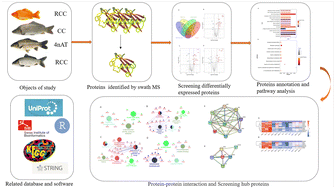Proteomics-based molecular and functional characteristic profiling of muscle tissue in Triploid crucian carp†
Abstract
Triploid crucian carp (TCC) is a kind of artificially bred fish with huge economic value to China. It has several excellent characteristics, such as fast growth, strong disease resistance and delicious taste. However, as a regionally specific fish, the underlying molecular mechanisms of these characteristics are largely unknown. In this study, we performed quantitative proteomics on the muscle tissues of TCC and its parents, allotetraploid (♂), red crucian carp (♀) and common carp. Combined with multiple bioinformatic analysis, we found that the taste of TCC can be mainly attributed to umami amino acid-enriched proteins such as PURBA, PVALBI and ATP5F1B, and that its rapid growth can be mainly ascribed to the high expression and regulation of metabolism-related proteins such as NDUFS1, ENO1A and CS. These play significant roles in substrate and energy metabolism, as well as in bias transformation. Subsequently, we identified several proteins, including MDH1AA, GOT1 and DLAT, that may serve as potential regulators of innate immunity by regulating the biosynthesis and transformation of significant antibiotics and antimicrobial peptides. In conclusion, this study can serve as a significant reference for similar investigations and shed light on the molecular and biological functions of individual proteins in TCC muscle tissue.



 Please wait while we load your content...
Please wait while we load your content...